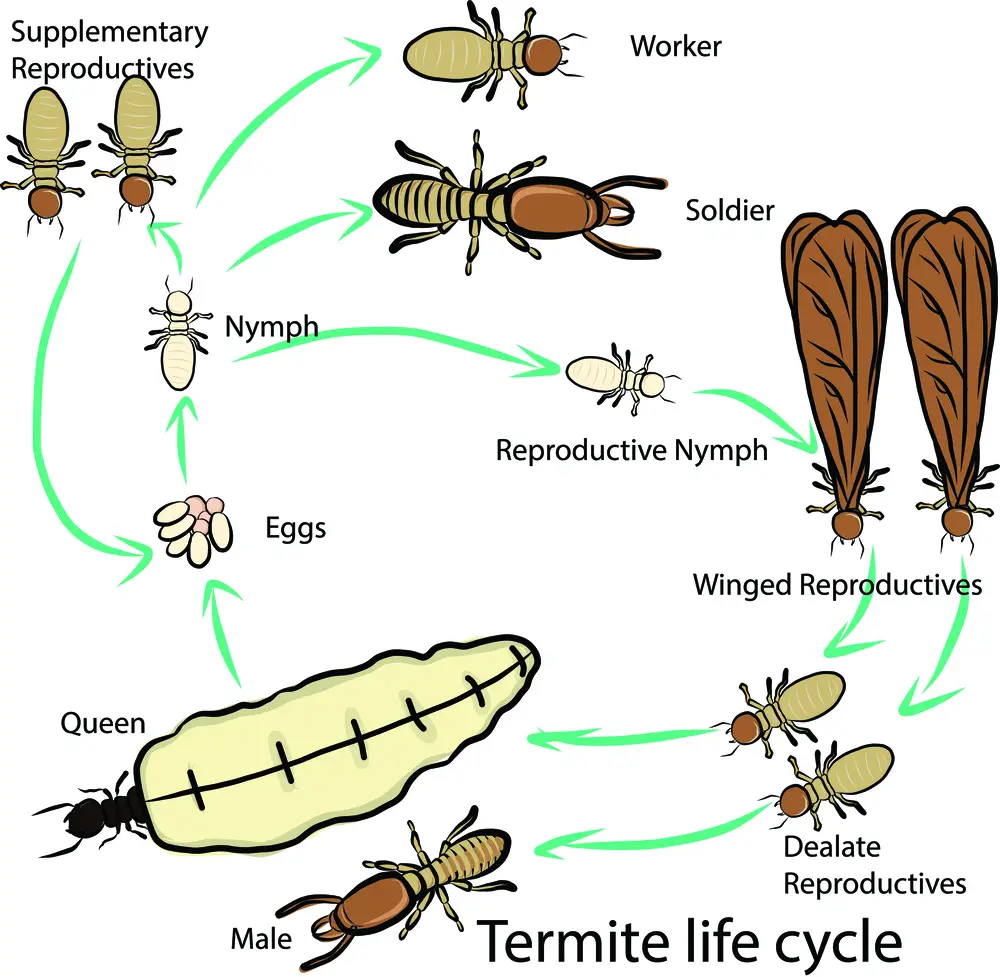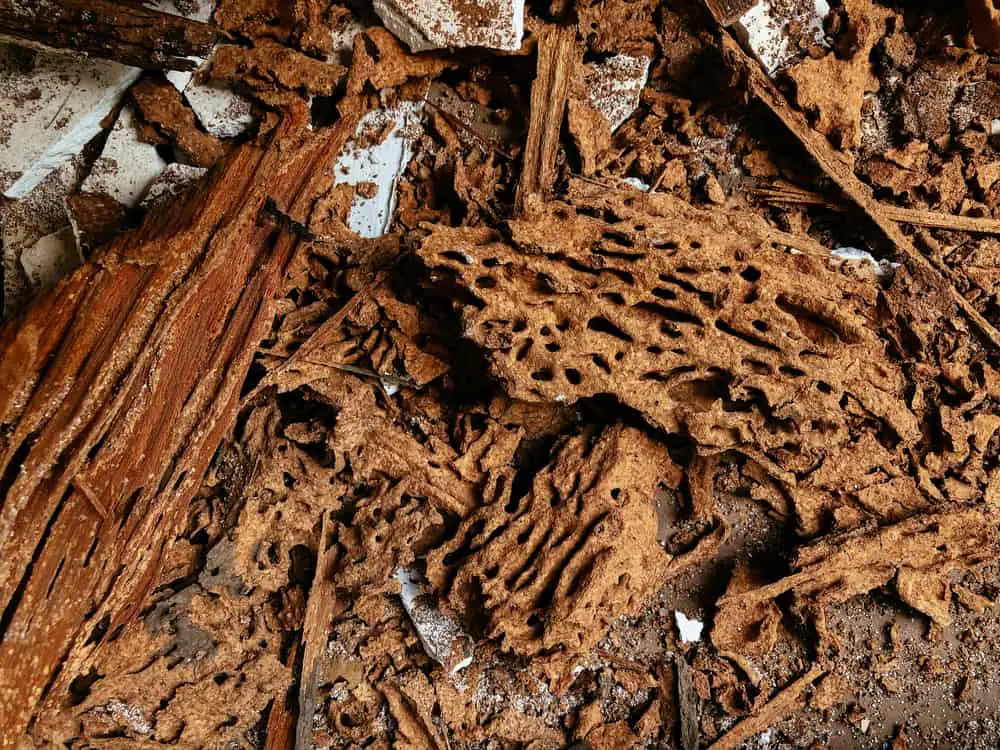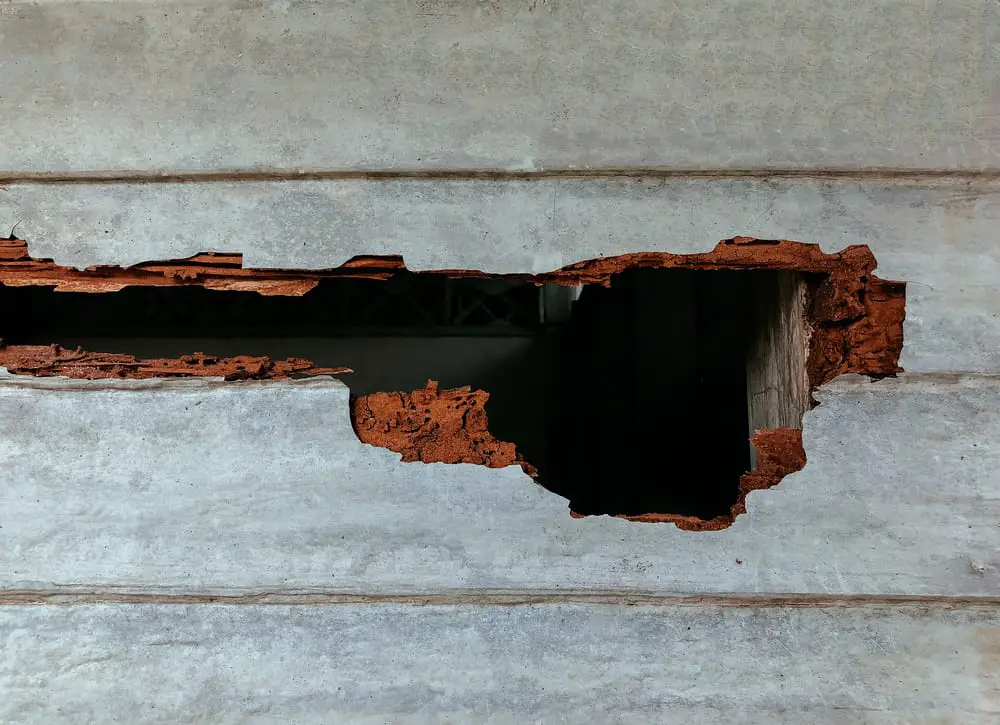When it comes to protecting our homes from pests, many homeowners focus on repelling or exterminating common insects like ants, mosquitoes, and flies. However, an often overlooked and highly destructive pest is the termite.
These wood-consuming insects can cause significant structural damage to buildings, resulting in costly repairs. As a homeowner, you may wonder whether your regular bug spray can also help eliminate termites.
Quick Answer:
Regular bug spray might kill termites on contact, but it’s not suited to eliminate an infestation. Termites often reside deep in wooden structures, and standard sprays won’t reach them. Specialized termite treatments and professional services are typically needed.
It is essential to understand the behavior and nature of termites before delving into the efficacy of various control methods.
Understanding Termites
Termite Colony Members: King, Queen, Workers, Soldiers, Swarmers
Termites live in colonies, consisting of different roles within their social hierarchy. The king and queen are responsible for reproduction, laying thousands of eggs to ensure the colony’s growth.
Workers are neutral termites, responsible for feeding other colony members and maintaining the nest. The soldiers are responsible for defending the colony from predators and other threats. Finally, swarmers are winged adult termites that leave the nest to establish new colonies.
Subterranean Vs. Drywood Termites
There are several species of termites, but the two main types are subterranean termites and drywood termites. Subterranean termites live underground, building their nests beneath the soil. These termites consume wood from the ground, making them particularly harmful to the foundations of homes and structures.
Drywood termites, on the other hand, burrow directly into the wood above ground and do not require contact with soil. Both species of termites use similar methods to break down cellulose in wood and can cause significant damage if left untreated.
The Termite Life Cycle

The life cycle of a termite begins as an egg. Eggs are laid by the queen, and after hatching, termites will progress through their life stages as larvae, nymphs, and eventually into reproductive or non-reproductive adults.
Termites undergo incomplete metamorphosis, meaning they do not undergo a complete transformation between life stages.
| Life Stage | Description |
|---|---|
| Egg | Laid by queen, initial stage of termite life cycle |
| Larva | Immature termites, molt several times before reaching next stage |
| Nymph | Intermediate stage, continue to molt until they become adults |
| Adult | Reproductive or non-reproductive termites, perform specific roles in colony |
The duration of the termite life cycle depends on the species and environmental factors, but it usually takes several months to years for a termite to reach maturity.
Signs of Termite Infestation
Visual Inspection
Performing regular visual inspections for termite infestations is crucial in maintaining the health of your home. Look for signs like discarded wings, shed exoskeletons, and termite droppings, also known as frass.
These indicators may suggest the presence of a termite colony nearby. Additionally, keep an eye out for swarms around your property, as this may be a sign of a budding infestation.
Termite Damage Signs

Termite damage often appears as a series of small holes, cracks, or weakened wood in structures. Termites primarily feed on cellulose, which can be found in wood, paper, and plants.
As they eat away at these materials, they create channels, causing damage that can weaken the structural integrity of your home if left untreated. Some common signs of termite damage include:
- Sagging or buckling floors
- Hollowed or damaged wooden beams
- Peeling or blistering paint that resembles water damage
Termite Mud Tubes and Tunnels
Termites construct protective mud tubes and tunnels to travel between their colony and food sources safely. These tunnels, made of mud, dirt, and termite droppings, provide the optimal environment for termites to thrive by maintaining the moisture and temperature.
Mud tubes can often be found on exterior walls, foundations, and crawl spaces. Some key things to look for are:
- Pencil-thin tubes running vertically or horizontally along surfaces
- Shelter tubes branching off of main tunnels to reach new food sources
- Nests constructed from soil and debris, typically found in damp or secluded areas
Termite Attraction Factors
Wood and Cellulose Sources
Termites are primarily attracted to wood and cellulose, as these materials are their main food source. They can consume both soft and hardwood, making houses and other wooden structures particularly susceptible to termite infestation.
Common sources of wood in homes include structural lumber, firewood, and wooden furniture.
In addition to wood, termites also feed on other cellulose-based materials such as paper, cardboard, and even certain types of insulation. Homes with extensive wooden features or excess cellulose materials can create a termite-friendly environment.
Outside the home, tree stumps and dead trees can attract termites. Having these near the house can increase the chances of a termite infestation. Additionally, trees and shrubs with branches touching the home may serve as entry points for termites to access the house.
Soil and Moisture Conditions
Termites thrive in moist environments, so soil and moisture conditions are key factors in attracting them. Subterranean termites, for example, build their colonies in the ground and require moist soil to survive.
They create mud tubes as a means to access food sources above the ground while maintaining a moist environment for their bodies.
Moisture conditions around a house can also increase the risk of a termite infestation. Common causes of excess moisture around homes include poor drainage, leaky pipes, and inadequate ventilation.
By fixing these issues, homeowners can reduce the likelihood of attracting termites and mitigate the risk of infestation.
Does Regular Bug Spray Kill Termites?
Insecticides Vs. Termiticides
Insecticides and termiticides serve different purposes in pest control. Insecticides are formulated to control a wide range of insects, while termiticides are specifically designed to target termites.
Although both insecticides and termiticides may contain similar active ingredients, their effectiveness, concentration, and application methods can vary.
Active Ingredients in Bug Sprays
Typical bug sprays contain active ingredients such as permethrin, bifenthrin, and imidacloprid. These chemicals can be effective against various insects, including ants, mosquitoes, and other crawling or flying pests.
However, their efficiency in killing termites may not be as high as termite-specific sprays that are specifically designed for termite control.
| Active Ingredient | Target Pests |
|---|---|
| Permethrin | Ants, mosquitoes, ticks |
| Bifenthrin | Ants, mosquitoes, termites |
| Imidacloprid | Ants, beetles, termites |
Termite-Specific Sprays Vs Regular Bug Sprays
Termite-specific sprays often contain active ingredients such as fipronil, hexaflumuron, or imidacloprid, which are specifically formulated to target termite colonies.
These termiticides differ from regular bug sprays in their mode of action and ability to eliminate termite colonies as a whole.
- Fipronil: Acts as a slow-acting poison that allows affected termites to return to the colony and spread the chemical to other termites, eventually eliminating the entire colony.
- Hexaflumuron: An insect growth regulator that disrupts termite growth and reproduction, leading to colony elimination.
- Imidacloprid: Targets the termite’s nervous system, causing paralysis and death. Although also used in some regular bug sprays, it is specifically formulated for termite control in specific products.
Professional Pest Control
Choosing a Pest Control Company
When dealing with termites, it is important to consult a professional pest control company. These professionals are equipped with the necessary tools, knowledge, and experience to effectively treat termite infestations.
The selection of a suitable pest control company should be based on factors like their reputation, service quality, and customer reviews. Research and compare different providers to ensure the best solution to your termite problem.
Orkin
Orkin is a leading pest control company with over a century of experience in the industry. They specialize in termite control, offering customized treatment plans to help protect your home and property.
Orkin employs highly trained technicians who undergo extensive training to effectively combat termite infestations. Their comprehensive termite treatment services can help prevent damage caused by termites.
Terminix Pest Control
Another trusted name in professional pest control is Terminix. They offer a wide range of services, including termite control solutions tailored to your specific needs. Terminix’s advanced techniques and technologies are designed to target termites effectively, ensuring a termite-free living environment.
With their skilled technicians and prompt service, Terminix is a reliable option for solving your termite problems.
DIY Termite Control
Termite Baits and Treatment Options
Termite baits are an effective and eco-friendly approach to controlling termites. Bait stations are placed around the perimeter of your home and contain a cellulose-based material that termites find attractive.
Termites consume the bait, which contains a slow-acting insecticide, and share it with their colony, eventually leading to a decrease in their numbers. Some popular bait station systems include Sentricon and Taurus SC.
- Two termite products IN one: pop-up indicators detect termite activity, and the stakes kill foraging termites
- Installs IN minutes: place stakes in the ground 2 to 3 feet away from your home and no more than 10 feet apart
- Pop-up indicator: check the stakes for termite activity when the pop-up indicator is seen
Liquid treatments, such as liquid termiticides, can be applied to the soil around your home to create a continuous barrier that keeps termites away.
The termites exposed to the chemical may die or become repelled, preventing them from entering the treated area. Some common liquid treatments include Termidor Foam and Taurus SC.
Home Remedies for Termite Control
There are also some home remedies that can help control termites. A few options include:
- Diatomaceous Earth (DE): DE is a natural, non-toxic material that can be sprinkled around the foundation of your home and in potential termite entry points. It works by dehydrating and damaging the exoskeletons of termites upon contact, leading to their death.
- Nematodes: These microscopic worms can be introduced into the soil, where they find and infect termites with a bacteria that kills them. Nematodes are natural predators of termites and can reduce the population effectively.
- Orange Oil: Made from the rinds of oranges, this oil can be applied directly to termite-infested wood, killing termites on contact. However, its effectiveness is limited to small areas of infestation.
For any DIY termite control efforts, it’s essential to monitor the situation regularly and consult a professional exterminator if needed.
Preventing Termite Infestations
Physical Barriers and Structural Adjustments
One effective termite prevention method is to use physical barriers to keep termites away from your home or building. You can install a steel mesh around the foundation, which prevents termites from entering through cracks. Additionally, cement foundations and barriers around utilities can keep termites at bay.
It is also crucial to maintain the structural integrity of your property. Address any signs of rot or damage promptly to prevent termites from finding a way in.
Ensure proper ventilation of crawlspaces and attics to prevent moisture buildup, which can attract termites. Fix any plumbing leaks and make sure downspouts and gutters are functioning and directing water away from the building.
Landscaping and Drainage Adjustments
When it comes to preventing termites, landscaping and drainage adjustments can make a significant difference. Be sure to maintain proper grading around your property to ensure water drains away instead of pooling near the foundation.
A well-maintained drainage system will reduce the potential for moisture buildup, which attracts termites.
Additionally, keep firewood and other cellulose-rich materials away from your building’s exterior. When possible, store firewood on raised platforms or concrete slabs to minimize contact with the ground.
Termite Prevention Strategies

Implementing termite prevention strategies can help protect your property from potential termite infestations.
Some common prevention methods include:
- Regular inspections: Schedule periodic inspections by a professional to identify any signs of termite activity or damage early on.
- Chemical treatments: Soil treatments and baiting systems can help deter termites from making their way into your home or building.
- Home maintenance: Keep siding, eaves, and vents clean and free from debris to minimize the conditions that can attract termites.
By combining physical barriers, structural improvements, and proactive strategies, you can effectively reduce the risk of termite infestations and protect your property.
Important Termite Facts and Myths
Misunderstanding Termite Behavior
Termites are often mistaken for ants due to their similar body structure. However, termites differ from ants in their feeding habits and lifestyle. Unlike ants, termites are detritivores, feeding primarily on dead plants and wood.
This makes them a threat to wooden structures in homes and other buildings.
Termites do not usually inhabit dark, damp areas like roaches or centipedes. They thrive in wood that is moist, with relative humidity levels of 70-90%. However, they can also cause damage to pipes and cracks in buildings by creating tunnels.
Contrary to popular belief, pesticides alone may not be enough to control a termite infestation. Fumigation and professional termite removal services are often required to fully eradicate them.
Debunked Termite Myths
Myth: Termites only swarm in the dark.
Fact: Termites can swarm in the daytime, too, especially after rainfall. Swarmers, also known as alates, are winged termites that leave the colony in search of new places to establish a nest. They are attracted to light and can swarm in broad daylight.
Myth: Regular insecticides are sufficient for termite control.
Fact: While some insecticides can kill termites on contact, they may not be effective in eliminating entire colonies. Specialized termiticides and baiting systems are needed to target the queen and colony members.
Myth: Termites can be easily detected by visible damage.
Fact: Termites are often called “silent destroyers” because they can cause extensive damage before being detected. Regular inspections by professionals and monitoring for telltale signs like mud tubes, damaged wood, and discarded wings from swarmers are essential in catching an infestation early.







